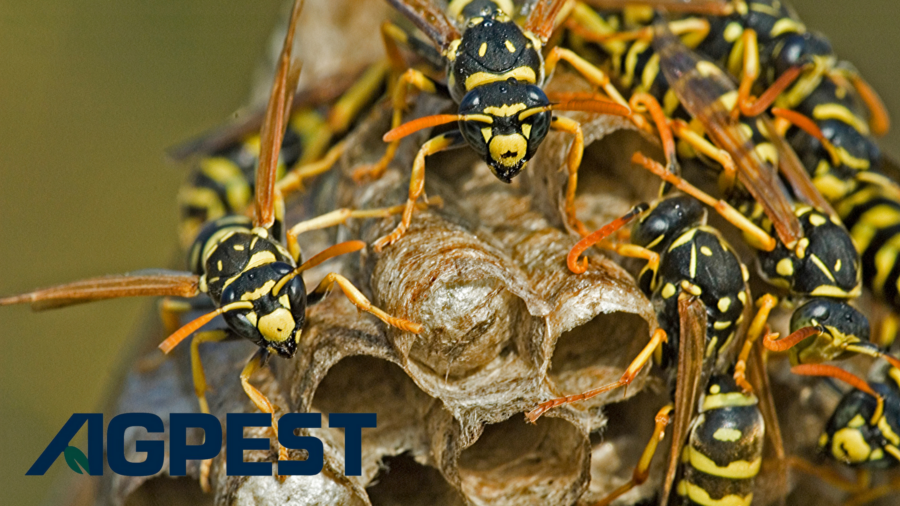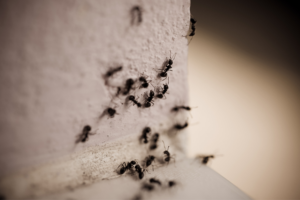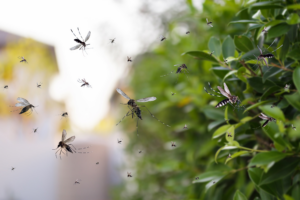San Diego’s warm climate attracts a variety of insects, including the often-misunderstood paper wasp. While these insects can be beneficial for natural pest control, their presence around homes and gardens can be concerning. This blog post explores paper wasp behavior, their potential threat to humans and pets, and effective prevention strategies.
Identifying Paper Wasps
Paper wasps are slender, with a narrow waist and long legs that dangle as they fly. They can vary in color, ranging from yellow to brown or even red, often with distinctive black markings. Their wings are typically folded longitudinally when at rest, giving them a unique appearance compared to other wasp species.
Common Nesting Sites
Paper wasps build their nests out of a papery substance they create by chewing wood fibers mixed with their saliva. These nests have a distinctive open-cell structure, resembling an umbrella. They are commonly found in sheltered areas such as eaves, overhangs, attics, shrubs, and even under outdoor furniture. The open design of the nest makes it easy to spot the wasps as they come and go.
Are Paper Wasps Aggressive?
Unlike some other stinging insects, paper wasps are generally not aggressive and will not go out of their way to sting humans or pets. However, they can become defensive if their nest is disturbed or they feel threatened. When a nest is agitated, paper wasps may sting repeatedly, unlike bees that can only sting once. This behavior can pose a risk, especially to those allergic to insect stings.
Dangers of Paper Wasp Stings
A paper wasp sting can be painful and cause localized swelling, redness, and itching. For most people, these symptoms are mild and subside relatively quickly. However, for those allergic to wasp venom, a sting can trigger a severe allergic reaction called anaphylaxis, which requires immediate medical attention. Pets, particularly curious ones, can also be at risk if they disturb a nest.
What to Do If You’re Stung by a Paper Wasp
If stung by a paper wasp, it is important to:
- Remove the Stinger: Unlike bees, wasps do not leave their stinger behind. However, if there are signs of a stinger, remove it gently.
- Clean the Area: Wash the sting site with soap and water to prevent infection.
- Apply a Cold Pack: This helps reduce swelling and pain.
- Use Over-the-Counter Remedies: Antihistamines or hydrocortisone cream can help alleviate itching and discomfort.
- Seek Medical Attention: If you experience difficulty breathing, swelling beyond the sting site, or other signs of an allergic reaction, seek emergency medical care immediately.
Preventing Paper Wasps from Nesting Around Your Property
To minimize the risk of paper wasps nesting near your home:
- Seal Entry Points: Ensure that potential nesting sites, such as cracks and crevices in walls or roofs, are sealed.
- Remove Food Sources: Paper wasps are attracted to sugary foods and proteins. Keep outdoor eating areas clean and cover food during picnics or barbecues.
- Regularly Inspect Your Property: Check for early signs of nests and remove them before they grow. It’s safest to do this at night when wasps are less active.
- Maintain Landscaping: Trim shrubs and trees regularly to reduce nesting sites.
- Use Wasp-Repellent Plants: Plants like mint, citronella, and eucalyptus can help deter wasps.
How to Get Rid of Paper Wasps
If you find a paper wasp nest on your property, it’s crucial to approach the situation with caution. DIY nest removal can be dangerous, especially if you have allergies or the nest is in a hard-to-reach area. For safe and effective removal, it’s best to contact a professional pest control company. Professionals have the expertise and equipment to handle the situation safely, ensuring that the wasps are removed without harm to you or your family.
At AgPest, we understand the importance of keeping your home safe from stinging pests like paper wasps. Our experienced technicians provide comprehensive pest control services, including safe removal of wasp nests and prevention strategies to keep your home wasp-free. Don’t take risks with DIY methods; protect your family and pets by letting the professionals handle it.



